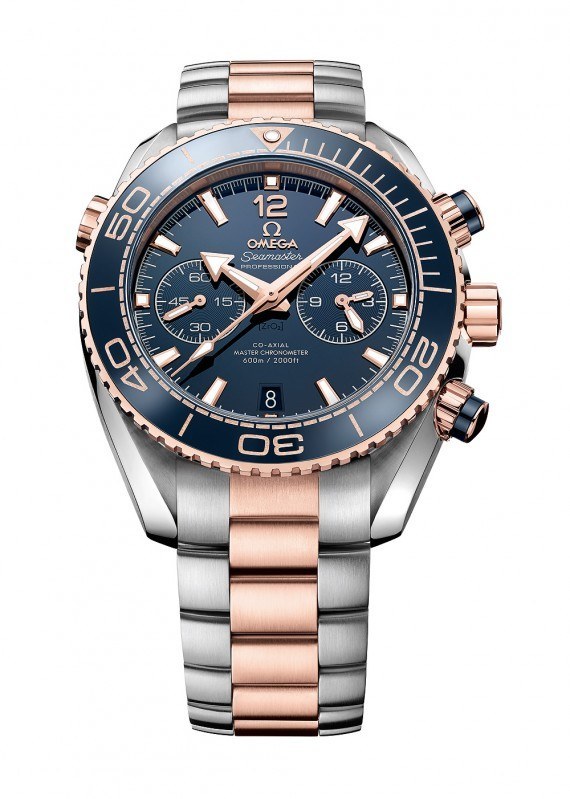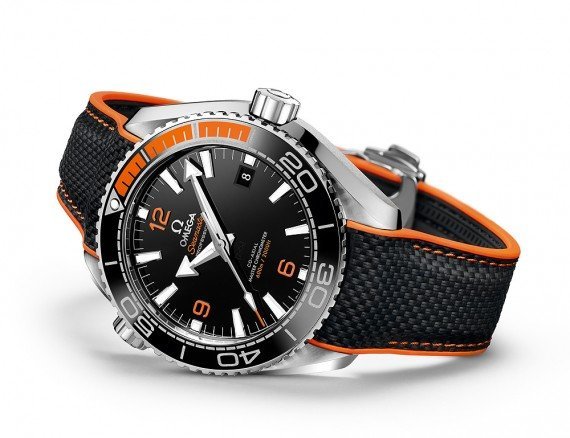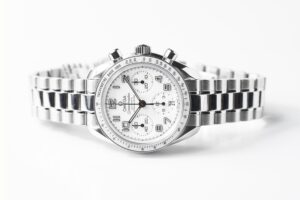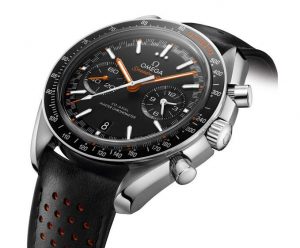
Omega had a big year at Baselworld, launching no less than six all-new Master Chronometer movements, all meeting the rigorous standards set by the Swiss Federal Institute of Metrology (METAS). We’ve already seen two of these new movements in Omega’s Globemaster Annual calendar and Speedmaster Moonphase; three more make their debut in new versions of Omega’s Seamaster Planet Ocean luxury dive watch series.

This year marks the first time that all Planet Ocean watches are Master Chronometers. The three new models — a three-hand automatic, a chronograph, and a GMT watch — feature new sizes and designs, thinner cases, and a variety of new materials, including the brand’s proprietary 18K Sedna gold, Liquidmetal®, rubber and ceramic.
The Omega Seamaster Planet Ocean 45.5mm Chronograph has a two-tone look, with a large case made of 18K Sedna gold and stainless steel and a bicolor bracelet combining the same materials. Both the dial and the unidirectional rotating bezel are in polished, deep blue ceramic; the numerals and diving scale notations on the bezel are in Omega’s own Ceragold material. The screw-down caseback, as on all the new Planet Ocean watches, is enhanced with an alveol wave pattern design. The movement in the watch is Omega’s Master Chronometer Caliber 9900, an automatic with a column-wheel chronograph function and a power reserve of 60 hours. Like all Master Chronometer calibers, it features a silicon balance spring and a co-axial escapement and is antimagnetic to 15,000 Gauss. The case is 18.87 mm thick and water-resistant to 600 meters. The dial’s bicompax design has a 60-minute and 12-hour chronograph counter combined in a single subdial at 3 o’clock, running seconds in a subdial at 9 o’clock, a central chronograph seconds hand, and a date window at 6 o’clock. The hands and applied indices are in Sedna gold and enhanced with Super-LumiNova. Also available in all-steel or all-Sedna gold versions with various bracelets and straps, prices on the chronograph range from $8,900 to $30,000.
The Seamaster Planet Ocean 43.5mm Auto marks another watch-world first for Omega, namely the blending of rubber with ceramic in a dive watch bezel. A bright orange rubber covers the first 15 minutes of the bezel’s dive scale, while Liquidmetal — a substance used in other Omega models and by other brands throughout the Swatch Group — is used for the numbers and scale increments. The 6000-meter water-resistant, 43.5-mm case is made of stainless steel (another model is available in titanium with a sandblasted titanium dial); the polished, black ceramic dial has new, applied Arabic numerals with an orange varnish. The structured rubber strap is black with a black-and-orange rubber inner lining. The watch is powered by the Master Chronometer Caliber 8900. Like all Semasters, it has a screw-down crown and a helium-release valve. Prices for the automatic start at $6,900 and reach $25,800 for a model in Sedna gold.
The Omega Seamaster Planet Ocean 43.50mm GMT, which contains Master Chronometer Caliber 8906, makes a stark, striking visual statement with its polished bi-ceramic [ZrO2] black-and-white bezel ring. This watch’s bezel, with its 24-hour numbered scale, rotates in both directions — it’s for displaying a second time zone, not for diving — and serves as a day-night indicator for the central GMT hand. The numerals and indices on the black and white sections are in the contrasing ceramic color (black on white, white on black) for easy legibility. The hands and indices are treated with Super-LumiNova (blue-colored for the hours, seconds, and GMT hands and green-colored for the minutes hand), as is the dot at 12 o’clock, which also glows green. The stainless steel watch comes on a black leather strap with rubber lining and is fitted with a foldover clasp in stainless steel. The watch costs $8,400 on a strap and $8,500 on a bracelet.







